

Dosimetric Evaluation of Cervical Oesophagus as an Organ at Risk in Breast Cancer Radiotherapy
Naveen Thimmaiah1, Nithin Bhaskar1, Ayushee Saini1, Rashmi Shivananjappa1, Tanvir Pasha1, Sathiyaraj Palanivel2, Nikhila Radhakrishna11Department of Radiation Oncology, Kidwai Memorial Institute of Oncology, Bangalore, India, 2Department of Radiation Physics, Kidwai Memorial Institute of Oncology, Bangalore, India,
Objectives: The current study intends to analyze dose-volume parameters of the cervical oesophagus (CO) as an organ at risk (OAR) during radiotherapy (RT) to the supraclavicular fossa (SCF) in breast cancer (BC) patients. Methods: Plans of 97 consecutive BC patients receiving 40 Gy/15 fractions were reviewed. The CO was retrospectively contoured from the cricopharyngeal junction to the sternal notch. Dmax, Dmean, V10, V20, and V30 to the CO, as well as the RT technique, were noted. Results: 53/97 patients had right BC, and 44/97 had left BC. 69/97, 17/97, and 11/97 were treated with 3DCRT, IMRT, and VMAT, respectively. Mean length of CO=8.3±1.3 cm; CO-Dmax=37.95±5.16 Gy; Dmean=17.48±7.7 Gy. Mean V10=60.12±26%, V20=41.75±24%, V30=25.04±19.8%. Patients with right BC had a lower CO-Dmax of 36.45±6.9 Gy and lower Dmean=14.54±7.12 Gy to CO, compared to left BC with CO-Dmax=39.75±2.4 Gy (p=0.017), and Dmean=21.2±7.2 Gy (p=0.0001). Conclusion: The cervical oesophagus receives significant doses in breast cancer patients during SCF irradiation, espe cially in left-sided breast cancer patients. Restricting and reporting doses to CO as an OAR must be adopted as a routine practice. Keywords: Breast cancer, cervical oesophagus, supraclavicular fossa
Cite This Article
Thimmaiah N, Bhaskar N, Saini A, Shivananjappa R, Pasha T, Palanivel S, et al. Dosimetric Evaluation of Cervical Oesophagus as an Organ at Risk in Breast Cancer Radiotherapy. EJMO. 2024; 8(3): 336-340
Corresponding Author: Nikhila Radhakrishna



